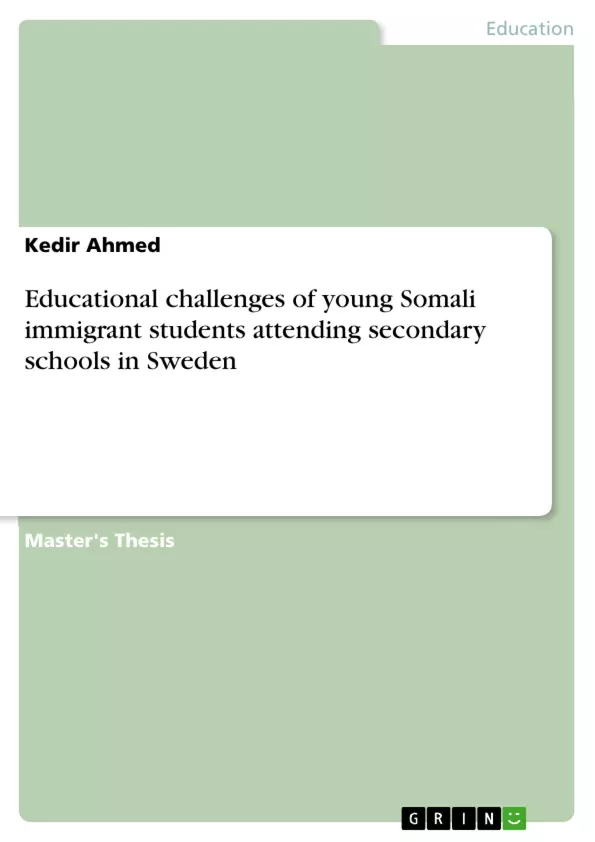Sweden has a long period of time been among the European countries that give asylum for many young immigrants from across the world. According to Swedish Statistics (2013), in 2012, 25% of the total numbers of immigrants to Sweden were children where 50% of the immigrants from Somalia and Afghanistan were minors and the total number of minor immigrants from Somalia increased with 70% in 2012. These young immigrants face different obstacles, including social problems and educational challenges after their arrival in Sweden. Studies show that young immigrant students in Sweden are having lower educational performance than their peer Swedish native speakers. This study identifies the challenges being faced by young Somali immigrants attending secondary schools in Sweden. The study focuses on children’s’ perspectives and examines their descriptions of their day to day life in school and the role of parents’ involvement in the education of their children. The study utilizes qualitative research method, interviews with young Somali students and review of previous researches. The research found that language barriers, lack of educational background by the students, complicated Swedish school system and students’ lack of integration are some of the major challenges faced by young Somali immigrants. Similarly, the study also revealed that lack of parental involvement due to lower educational background, unfavorable condition of home environment and lower economic status of their families are among the key factors that contribute on the lower educational performance of the students.
Inhaltsverzeichnis (Table of Contents)
- CHAPTER 1: INTRODUCTION.
- 1.1. Background information
- 1.1.1 Migration to Sweden.
- 1.2. Aim of the study.
- 1.3. Research questions........
- 1.4. Constraints of the Present Research.
- 1.5. Outline of chapters
- CHAPTER 2: REVIEW OF THE PRIOR RESEARCH.
- 2.1. Language and Communication skills in Education...
- 2.1.2. Importance of language for adaptation and integration...........
- 2.2. Educational Background and Schooling system ..
- 2.2.1. Swedish educational system............
- 2.2.2. Education in Somalia.....
- 2.3. Social integration and Cultural differences.….…….......
- 2.4. Parental Involvement..........\li>
- 2.4.1. Importance of parental involvement..\li>
- 2.4.2. Barriers to parental involvement...\li>
- 2.5. Impact of family size and home accommodation on children's academic performance..\li>
- 2.6. Low income families and its impacts on students' education.
- CHAPTER 3: METHODOLOGY.
- 3.1. Research Design..............
- 3.1.1. Qualitative Research and semi-structured interviews...\li>
- 3.1.2. Data collection.
- 3.1.3. Presentation of participants............
- 3.1.4. Data Analysis
- CHAPTER 4: Findings and Analysis..\li>
- 4.1. Language barriers..\li>
- 4.2. Educational background of the students as part the educational barriers. ….…………….…………..\li>
- 4.3. Swedish School System as a challenge for young Somali students .……….….….….……….….…….\li>
- 4.4. Socio-cultural factors and students' difficulties in integration.….….….….….….….….…..\li>
- 4.5. Parental challenges.
- 4.5.1. Parent's low educational background.\li>
- 4.6. Family size and home environment as a factor for low educational performance 28
- 4.7. Low economic status of the family as a challenge for educational attainment.........30
Zielsetzung und Themenschwerpunkte (Objectives and Key Themes)
This study examines the educational challenges faced by young Somali immigrants attending secondary schools in Sweden. It focuses on the perspectives of these students, exploring their daily experiences in school and the role of parental involvement in their education. The research aims to identify the specific obstacles these students encounter and the factors that contribute to their lower educational performance compared to Swedish native speakers.
- Language barriers and communication skills
- Educational background and schooling systems
- Social integration and cultural differences
- Parental involvement in education
- Economic factors and their impact on educational attainment
Zusammenfassung der Kapitel (Chapter Summaries)
Chapter 1 introduces the background of Somali immigration to Sweden and outlines the study's objectives, research questions, and limitations. It also presents a summary of the chapters to follow. Chapter 2 reviews existing research on language and communication skills, educational background and schooling systems, social integration, parental involvement, and the impact of family size, home environment, and low income on students' education.
Chapter 3 outlines the methodology used in the study, including the qualitative research design, semi-structured interviews, data collection, presentation of participants, and data analysis. Chapter 4 presents the findings and analyses of the study, focusing on language barriers, educational background, the Swedish school system, socio-cultural integration difficulties, parental challenges, and the impact of family size, home environment, and low economic status on educational performance.
Schlüsselwörter (Keywords)
This research focuses on the educational challenges faced by young Somali immigrants in Sweden. Key themes explored include language barriers, educational background, social integration, parental involvement, low income, and the impact of these factors on educational performance.
- Quote paper
- Kedir Ahmed (Author), 2015, Educational challenges of young Somali immigrant students attending secondary schools in Sweden, Munich, GRIN Verlag, https://www.grin.com/document/307025



